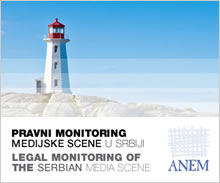21. 10. 2011
The Media Strategy – was it worth 11 years of waiting?
Belgrade, October 21, 2011 (Source: MC Newsletter) - It is hard to believe that it took 11 years for Serbia to adopt a Media Strategy.
In other words, media laws have been adopted without this framework document, which has resulted in contradictions and lack of harmonization between their provisions.
It is no wonder then, that media professionals have closely followed the preparation of this document and thoroughly analyzed its content.
As a witness to the torturous process that took almost two years to complete, I have to admit that one of the key benefits of the strategy is the fact that during its preparation a media coalition was formed consisting of five media associations and organizations (The Association of Independent Electronic Media - ANEM, The Independent Journalists' Association of Serbia - NUNS, The Journalists' Association of Serbia - UNS, and The Journalists' Association of Vojvodina - NDNV). This media coalition, together with the Media Association, has become an influential media entity that prior to this had not been present in the local public scene in this way.
Unfortunately, although it has been adopted with mutual compromises, the Media Strategy mostly does not solve any of the existing problems, but instead prolongs and delays their solving.
Our persistent insistence on privatization is based on the fact that state-owned media suffer from impermissible influence of the government on their editorial policy and disrupt the market.
The state-owned media have already been required to act in accordance with the public interest and to maintain editorial independence.
These requirements have not been met and we can quite justifiably expect that the situation will not change in the future.
Unfortunately, the Strategy has advanced in the wrong direction, because the number of media outlets not to be privatized has been increased (the minority media and regional public service broadcasters).
I am afraid that allowing the councils of national minorities to run the media will result in abuse of such media outlets by political parties that are dominant in the councils.
Aside from this, the idea about formation of regional public service broadcasters in six cities will lead to a political struggle during selection of these cities and privatization will be further delayed.
The Strategy does not offer any solution on how to select future regional public service broadcasters, their composition, nor their financing (especially now, when only 40% of the citizens pay the TV fee).
The Strategy does mention that the media will be financed in accordance with the rules on allocation of state assistance - which are still non-existent.
But we do have rules on control of state assistance which stipulate what is not allowed - disruption of competition in the market, overpaying, lack of transparency and control...
After reading the Strategy, it is still unclear how the informing at the local level will be regulated in the future.
If we accept the assumption that Radio-Television Serbia (RTS) and Radio-Television Vojvodina (RTV) do not satisfy the needs of citizens at the regional level, necessitating the formation of regional public service broadcasters, who can guarantee that soon some politicians will not support the idea of creating local public service broadcasters - in the same way that they now support the creation of the regional ones?
Is there any end in sight and whose appetites are we actually supposed to satisfy?
These dilemmas have been emphasized by media organizations and associations. They have realized that formation of regional public service broadcasters was the "cuckoo in the nest" in the Media Strategy.
Therefore it is not surprising that we have unanimously rejected all provisions related to this concept of future regulation in the field of electronic media (and not only electronic media).
We can only hope that the implementation of new rules on allocation of state assistance (which are effective as of New Year) will solve numerous uncertainties related to financing of the state-owned media.
In the future, the principle of project-based financing of content in public interest should remain a basis for our advocacy of legal regulations related to and resulting from the media strategy.
It will be a long and arduous process... just like the one that has resulted in adoption of the Media Strategy.
Sasa Mirkovic
-
No comments on this topic.





